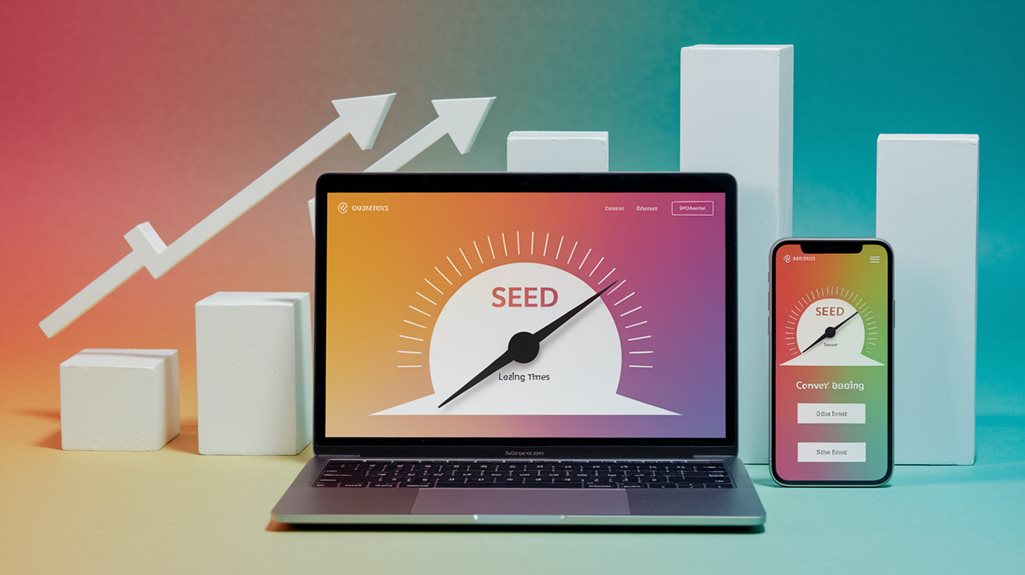
The Real ROI of Quality Web Design: Why Your Website Is Your Best Salesperson
Quality web design delivers measurable ROI through faster load times, intuitive navigation, and mobile optimization. Research shows each second of improved speed increases conversions by 7%, while poor design can erode trust within 50 milliseconds. Professional elements like SSL certificates and strategic CTAs guide visitors toward conversion, resulting in 23% higher conversion rates for companies prioritizing trust. These design investments transform websites into 24/7 sales tools that consistently outperform their poorly designed counterparts.
Expert Highlights
- Quality web design directly impacts ROI with one-second faster load times increasing conversions by 7%.
- Professional design establishes trust within 50 milliseconds, with trust-focused companies seeing 23% higher conversion rates.
- Mobile-optimized websites can improve conversion rates by 15-30% as 60% of transactions occur on mobile devices.
- Data-driven design decisions reduce bounce rates by 32% and significantly increase customer retention.
- Strategic navigation and clear CTAs create frictionless conversion paths that work 24/7 unlike human salespeople.
First Impressions: How Load Speed and Visual Appeal Impact Conversion Rates

First impressions, much like handshakes in business meetings, set the tone for a visitor’s entire experience on a website. Research shows that 47% of users expect pages to load within two seconds, with abandonment rates increasing dramatically after three seconds. This immediate exodus translates directly to lost revenue—a one-second delay can reduce conversions by 7%.
Beyond speed, visual cohesion creates psychological trust. Sites with professional aesthetics, consistent color schemes, and intuitive navigation report conversion rates up to 200% higher than their cluttered counterparts. Companies addressing these elements see tangible results: Amazon calculated that every 100ms of improved load time generated a 1% revenue increase. Implementing proper technical SEO implementation can dramatically improve site speed and mobile responsiveness, two critical factors that directly influence user experience and conversion rates.
The Psychology Behind User Experience (UX) and Purchase Decisions

When users navigate through a website, their subconscious minds process dozens of subtle cues that ultimately influence purchase decisions. Understanding these psychological triggers allows businesses to design interfaces that naturally guide visitors toward conversion.
Four key psychological principles that impact purchasing behavior:
- Cognitive load – Simplified navigation reduces mental effort, making decisions easier
- Social proof – Reviews and testimonials create trust through community validation
- Color psychology – Strategic color choices evoke specific emotions that facilitate action
- Choice architecture – Thoughtful presentation of options guides users toward preferred selections
These elements, when properly implemented, create an environment where visitors feel comfortable, understood, and confident in their purchasing decisions. Our team combines web design expertise with development knowledge to create seamless interfaces that strategically implement these psychological principles for maximum conversion potential.
Mobile Optimization: Capturing Revenue From On-The-Go Customers

Mobile optimization has become the cornerstone of e-commerce success, with over 60% of online transactions now occurring on smartphones and tablets. Companies that implement thumb-friendly navigation, optimize loading speeds under three seconds, and employ responsive design frameworks consistently report conversion rate improvements of 15-30% compared to desktop-only experiences. The “design once, display everywhere” approach not only reduces development costs but guarantees customers receive a seamless shopping experience regardless of device, addressing the critical challenge that 73% of mobile users abandon sites that fail to adapt to their screen size. Businesses implementing custom app development solutions have reported a 300% average increase in user engagement compared to standard mobile websites.
Thumb-Friendly Navigation Essential
Nearly every smartphone user navigates websites with their thumbs, making thumb-friendly design not just a preference but a necessity for businesses seeking mobile revenue. Companies ignoring this critical aspect risk alienating 70% of their mobile visitors, who abandon difficult-to-navigate sites within seconds.
Four thumb-friendly navigation essentials include:
- Menus positioned at screen bottom within thumb’s natural arc
- Touch targets measuring at least 44×44 pixels for accurate tapping
- Strategic placement of key conversion elements in the “thumb zone”
- Adequate spacing between clickable elements to prevent frustrating mis-taps
Implementing these elements transforms struggling mobile interfaces into intuitive experiences that keep customers engaged, satisfied, and ready to complete purchases.
Loading Speed Matters
Website visitors consistently abandon pages that take longer than three seconds to load, making loading speed a critical factor in mobile commerce success. Studies show that each additional second of load time reduces conversion rates by 7%, directly impacting revenue generation. Slow-loading sites create a disconnection between customers and brands they want to engage with.
Implementing image compression, browser caching, and content delivery networks can dramatically improve loading times. Companies that optimize their mobile page speed see 20% higher engagement rates and stronger customer retention. These technical improvements create an inclusive experience where visitors feel valued rather than frustrated, building the foundation for lasting relationships that convert browsers into loyal customers.
Design Once, Display Everywhere
As consumer habits shift toward on-the-go browsing, responsive design has become essential rather than optional for businesses seeking to maximize their digital revenue streams. Modern websites must adapt seamlessly across devices to capture sales from the increasingly mobile customer base.
Mobile optimization directly impacts revenue through:
- Decreased bounce rates – 53% of mobile users abandon sites that take longer than 3 seconds to load
- Expanded customer reach – capturing the 70% of internet users who browse primarily on smartphones
- Higher conversion rates – properly optimized mobile sites convert up to 64% more visitors
- Improved search rankings – Google prioritizes mobile-friendly sites in search results
Data-Driven Design: Leveraging Analytics to Increase Sales Performance
Numbers tell the story that intuition often misses when it comes to effective web design. By analyzing user behavior patterns, companies can identify exactly where potential customers abandon carts, which design elements attract clicks, and what content drives conversions.
Many businesses struggle with design decisions based on assumptions rather than evidence. The solution lies in implementing robust analytics tracking that measures key performance indicators across devices and user segments. When organizations apply these insights to refine navigation paths, optimize calls-to-action, and personalize user experiences, the results are measurable: increased time-on-site, higher conversion rates, and ultimately, improved sales performance that directly impacts bottom-line revenue.
Implementing a data-driven approach to web design has proven successful for e-commerce retailers who experienced 215% list growth and significant conversion improvements through optimized digital touchpoints.
The Hidden Cost of Poor Website Design on Customer Retention
Research consistently shows that poor website design functions as a critical factor in eroding user trust within the first 50 milliseconds of interaction, leading to measurable drops in customer retention metrics. When visitors encounter slow load times, confusing navigation, or unprofessional visuals, they typically associate these design failures with organizational incompetence, creating negative impressions that extend beyond the digital experience. Companies that neglect website quality often experience retention rate decreases of 30-45% compared to competitors with polished, user-focused designs, translating directly to significant revenue losses that frequently go unattributed to their actual source. This is why WebLeadsNow’s team of experts prioritizes user experience optimization when creating custom, responsive websites that drive both engagement and conversions.
Trust Erodes Quickly
While many businesses focus primarily on acquiring new customers, the often-overlooked reality is that trust—once established—can erode with alarming speed when visitors encounter a poorly designed website.
Research shows trust deterioration happens within seconds when users experience:
- Slow loading pages (40% abandon sites that take over 3 seconds to load)
- Difficult navigation that forces users to hunt for information
- Outdated content suggesting neglect or indifference
- Security concerns like missing HTTPS certification
These issues signal to customers that a company may be equally careless with their orders, data, or service quality—ultimately driving them to competitors whose digital presence demonstrates attentiveness and reliability.
Retention Metrics Plummet
The erosion of trust directly impacts measurable performance indicators across businesses with subpar websites. When visitors encounter slow loading times, broken links, or confusing navigation, they abandon sites at alarming rates. Studies show that bounce rates increase by 32% on poorly designed websites, while average session duration drops by nearly half.
This mass exodus devastates retention metrics that directly affect revenue. Companies with outdated websites experience 67% lower return visitor rates and greatly reduced customer lifetime value. The solution lies in professional, user-focused design that prioritizes intuitive navigation, mobile responsiveness, and fast loading speeds—transforming casual browsers into loyal customers who return repeatedly, dramatically improving both retention rates and bottom-line results.
Strategic CTAs and Navigation: Guiding Visitors Toward Conversion
Effective website design hinges on carefully planned calls-to-action (CTAs) and intuitive navigation that shepherd visitors toward desired outcomes. When customers struggle to find what they need, they abandon sites, leaving potential revenue untapped. Strategic navigation and CTAs transform this experience.
Four essential elements of conversion-focused design include:
- Prominently placed CTAs with action-oriented language (“Get Started” vs. “Submit”)
- Clear navigation paths that mirror customer journey stages
- Visual hierarchy that guides eyes toward conversion points
- Mobile-responsive design ensuring CTA visibility across devices
Implementing these elements creates a frictionless path where visitors naturally progress toward decisions, markedly increasing conversion rates without aggressive selling tactics. Similar to how SaaS applications scale to meet increasing user demands, effective websites must scale their conversion capabilities through strategic design choices.
Building Trust Through Professional Design Elements and Security Features
Trust emerges as a critical foundation for conversion success, manifesting through both visual professionalism and tangible security features. Visitors make split-second judgments about credibility based on design consistency, typography choices, and image quality. Sites lacking these elements face abandonment rates up to 38% higher than their polished counterparts.
Implementing visible trust signals—SSL certificates, secure payment icons, and privacy policy links—addresses visitor hesitation directly. Professional design elements like consistent branding, appropriate white space, and readable fonts work alongside technical security measures to create a complete trust ecosystem. Companies that prioritize both aspects experience 23% higher conversion rates than those focusing solely on functionality.
Measuring Success: Key Metrics That Prove Your Website’s Sales Power
Validating website performance requires concrete metrics beyond intuitive design and security features. Organizations seeking to quantify their digital investment must track specific indicators that demonstrate real business impact.
Meaningful web analytics transform abstract design elements into quantifiable business results that justify digital investments.
Four essential metrics that reveal website sales effectiveness:
- Conversion rate – percentage of visitors who complete desired actions
- Average order value – typical purchase amount per transaction
- Customer acquisition cost – total marketing spend divided by new customers gained
- Bounce rate – percentage of single-page visits without further interaction
These measurements transform abstract design concepts into tangible financial outcomes. When tracked consistently, they provide clear evidence of design improvements‘ impact on revenue, allowing teams to refine strategies based on data rather than assumptions.
Frequently Asked Questions
How Long Should a Website Redesign Typically Take?
A website redesign typically takes 2-4 months depending on complexity, stakeholder input, and project scope. Many companies find this timeline allows for thoughtful implementation while maintaining momentum.
What’s the Average ROI Timeframe for Quality Web Design Investment?
Quality web design typically shows ROI within 3-6 months, though complete results often manifest at 12-18 months. With strategic implementation, community members see faster returns on their digital investment.
Should I Hire an Agency or Freelancer for My Website Design?
The choice depends on project scope and budget. Agencies offer extensive services but cost more, while freelancers provide personalized attention at lower rates. Many businesses find their tribe with either option.
How Often Should I Update My Website Design?
Websites should be refreshed every 2-3 years, with minor updates quarterly. However, this cadence varies by industry trends, company growth, and audience preferences. Regular assessments guarantee ideal user experience.
What Website Features Deliver the Highest Conversion Rate Improvements?
Clear CTAs, intuitive navigation, mobile responsiveness, fast loading speeds, compelling headlines, social proof, and simplified checkout processes consistently deliver the highest conversion rate improvements for websites.
Expert Final Thoughts
A well-designed website serves as an invaluable salesperson, working tirelessly to convert visitors into customers. By investing in quality design elements—from fast loading speeds to strategic CTAs—businesses create a foundation for sustainable growth. The ROI extends beyond immediate sales to include enhanced customer retention and brand credibility. In today’s digital marketplace, companies cannot afford to overlook their website’s critical role in driving business success.